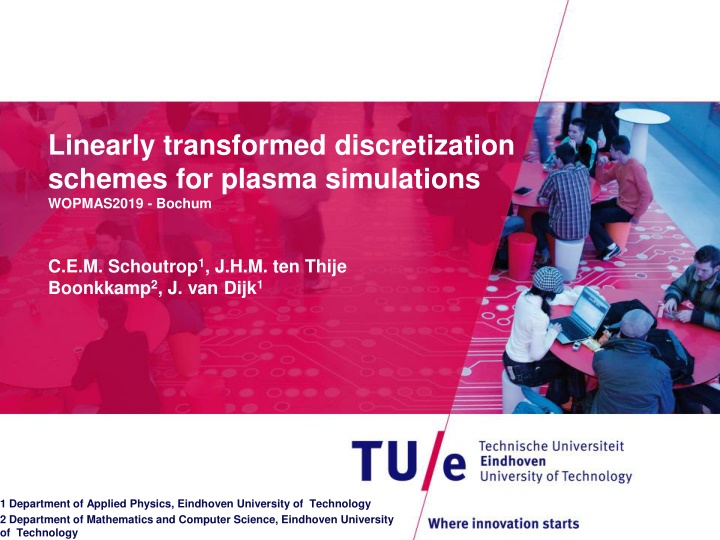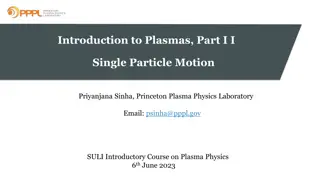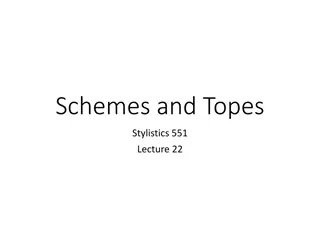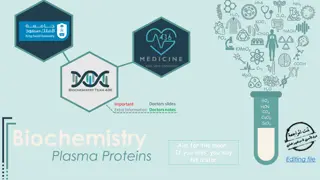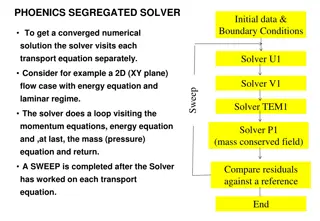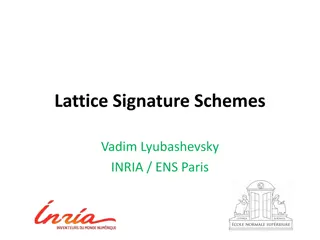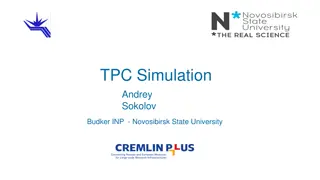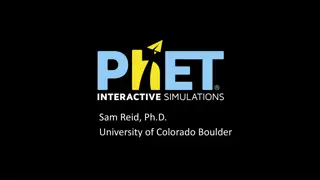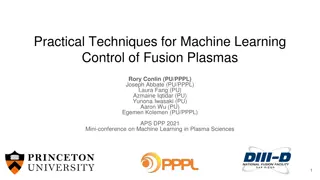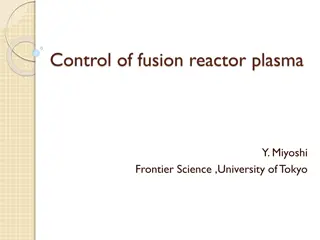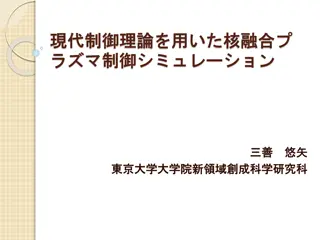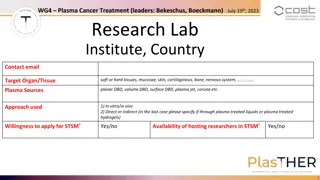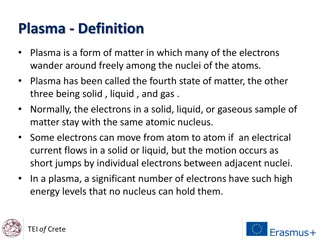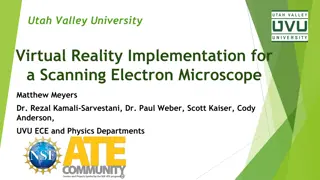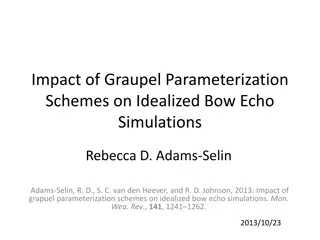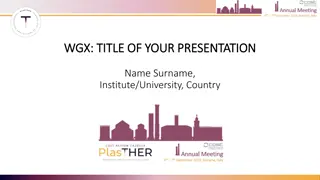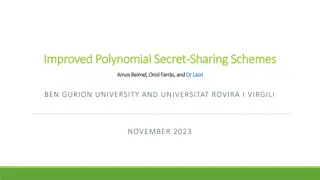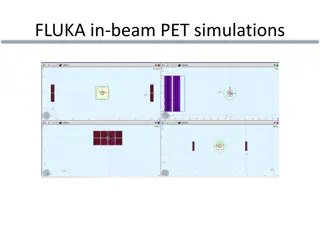Linearly Transformed Discretization Schemes for Plasma Simulations
Addressing the computational challenge of CO2 decomposition with plasmas, this study focuses on developing advanced discretization schemes and modern iterative linear solvers to ensure physical invariants are respected. The research explores the use of chemical invariants to simplify complex systems in plasma simulations, emphasizing the need for representative simulations in intrinsically 3D scenarios. Drift-diffusion equations and chemistry models are discussed, highlighting the application of time stepping for numerical experiments with source terms containing chemical reactions.
Download Presentation

Please find below an Image/Link to download the presentation.
The content on the website is provided AS IS for your information and personal use only. It may not be sold, licensed, or shared on other websites without obtaining consent from the author.If you encounter any issues during the download, it is possible that the publisher has removed the file from their server.
You are allowed to download the files provided on this website for personal or commercial use, subject to the condition that they are used lawfully. All files are the property of their respective owners.
The content on the website is provided AS IS for your information and personal use only. It may not be sold, licensed, or shared on other websites without obtaining consent from the author.
E N D
Presentation Transcript
Linearly transformed discretization schemes for plasma simulations WOPMAS2019 - Bochum C.E.M. Schoutrop1, J.H.M. ten Thije Boonkkamp2, J. van Dijk1 1 Department of Applied Physics, Eindhoven University of Technology 2 Department of Mathematics and Computer Science, Eindhoven University of Technology
Introduction CO2 decomposition with plasmas Computational challenge: -Intrinsically 3D -Complex chemistry -Strong advection / Applied Physics 5-12-2019 PAGE 1
Introduction Often badly conditioned systems Loss of relevant conserved quantities Idea: Exploit chemical invariants to simplify system[1] / Applied Physics 5-12-2019 PAGE 2
Setup requirements Strong flow, central difference explodes Intrinsically 3D, need for iterative linear solver[2] Simulation must be representative Setup requirements: -Advanced discretization scheme -Modern iterative linear solver -Ensure physical invariants are respected / Applied Physics 5-12-2019 PAGE 3
Drift-Diffusion equation Underlying conservation law Specific 1D case for experiments diagonal, based on Stefan Maxwell & ambipolar Diffusion does not transport net mass Diffusion does not transport net charge / Applied Physics 5-12-2019 PAGE 4
Chemistry 1D drift-diffusion for numerical experiments Interested in steady state Apply time stepping to time-dependent problem Source term contains chemical reactions Example: / Applied Physics 5-12-2019 PAGE 5
Chemistry Arbitrary chemical reaction source-term: Argon example: Not full rank / Applied Physics 5-12-2019 PAGE 6
Chemistry Arbitrary reaction source-term: Not full rank, therefore special transformation exists Argon example: Charge invariant Argon invariant / Applied Physics 5-12-2019 PAGE 7
Transformed system General: Number of zero rows of equals Original diff. eq. Transformed diff. eq. / Applied Physics 5-12-2019 PAGE 8
Transformed system Properties transformed diff. eq. (Steady state) Expanded form: It can be shown that given triangular: If the diffusion matrix transforms in a specific way, then the source-less quantity is constant / Applied Physics 5-12-2019 PAGE 9
Numerical experiment argon 3 Species (Ar, Ar+,e-), 2 Chemical invariants Compare original & transformed solutions Original Transformed const 0 Te=Ti=104K Pressure=103Pa mass_flux=-2 kgm^-2s^-1 / Applied Physics 5-12-2019 PAGE 10
Numerical experiment argon Two sources transformed to 0 Original Transformed 0 Te=Ti=104K Pressure=103Pa mass_flux=-2 kgm^-2s^-1 / Applied Physics 5-12-2019 PAGE 11
Transformed diffusion matrix Transformed diffusion matrix structure / Applied Physics 5-12-2019 PAGE 12
Transformed argon It can be shown that given triangular: This happens if left-eigenvectors of are rows in From the argon example: Has the solution (given correct B.C.): / Applied Physics 5-12-2019 PAGE 13
Exact conserved quantities In general: There exists a transformation, such that: If an invariant is conserved by the diffusion (e.g. diffusion does not transport mass and charge) And if the boundary conditions respect the invariant Then a source-less transformed conserved quantity is constant (In principle) Exact conservation of mass and charge Applies to discretized systems as well / Applied Physics 5-12-2019 PAGE 14
Resulting charge/mass conservation Significant improvement 108 109 / Applied Physics 5-12-2019 PAGE 15
Additional scaling Starting with discretization matrix Scale rows with matrix ; Scale columns of with matrix ; Cheap additional step / Applied Physics 5-12-2019 PAGE 16
Numerical experiment condition number Additional row/column scaling strong effect After scaling notable reduction Unscaled Scaled 105 103 / Applied Physics 5-12-2019 PAGE 17
Effect on iterative methods Argon system result, 21 gridpoints BiCGStab, 1e-12 tolerance, 13000 max iterations Condition no. Unscaled Untransformed 1.9e+17 Transformed 2.0e+22 Scaled 4.9e+05 7.1e+02 Iterations Untransformed Transformed Unscaled 13000 13000 Scaled 3246 75 Residual Untransformed Transformed Unscaled 0.03 0.02 Scaled 6.5e-13 9.7e-13 / Applied Physics 5-12-2019 PAGE 18
More advanced iterative method Argon system result, 21 gridpoints IDRStab[3], 1e-12 tolerance, 2000 max iterations Condition no. Unscaled Untransformed 1.9e+17 Transformed 2.0e+22 Scaled 4.9e+05 7.1e+02 Iterations Untransformed Transformed Unscaled 2000 2000 Scaled 301 38 Residual Untransformed Transformed Unscaled 0.03 0.002 Scaled 7.1e-13 9.2e-13 / Applied Physics 5-12-2019 PAGE 19
Conclusion Transformation used to eliminate part of source term Numerical scheme reproduces invariants Scaling significantly reduces condition number Transform+scale yields fastest convergence iterative linear solver / Applied Physics 5-12-2019 PAGE 20
Additional current projects IDRStab implementation in Eigen[4] Sparse linear algebra Recursive integration schemes Eigendecomposition chem. reduction (concept) / Applied Physics 5-12-2019 PAGE 21
